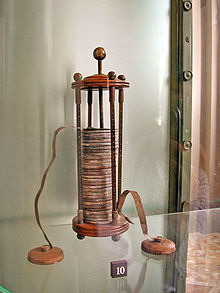Alessandro Volta
Alessandro Giuseppe Antonio Anastasio Volta (February 18, 1745-ib., March 5, 1827) was an Italian chemist and physicist, famous primarily for the discovery of methane. in 1776 and the invention and development of the electric battery in 1799. The SI unit of electromotive force has been named volt in his honor since 1881.
Biography
Alessandro Volta, or Count Alessandro Giuseppe Antonio Anastasio Volta, physicist and pioneer in the study of electricity, was born in Lombardy, Italy, on February 18, 1745, into a noble family in Como, Italy. He was the son of a noble mother and an upper-class father. At the age of seven his father died and the family had to take care of his education. From an early age he was interested in physics and despite his family's desire that he study a legal career, he managed to study science. His basic and secondary education were in the humanities, but upon reaching higher education, he opted for a scientific background.
In 1774 he was appointed professor of physics at the Royal School of Como. A year later, Volta made his first invention, a device related to electricity. With three metallic discs separated by a wet conductor, but joined with an external circuit. In this way, he succeeded for the first time in producing direct electric current, inventing the perpetual electrophore, a device that, once charged, can transfer electricity to other objects, and that generates static electricity. Between 1776 and 1778, he devoted himself to chemistry, discovering and isolating methane gas.
In 1779, he became professor of experimental physics at the University of Pavia, a chair he held for nearly 40 years. The Volta lectures were so packed with students that the later Emperor Joseph II ordered the construction (based on a project by Leopold Pollack) of a new "physical theater", today the "Aula Volta". In addition, the Emperor gave Volta substantial funding to equip the physics cabinet with instruments, purchased by Volta in England and France. In the Museum of History of the University of Pavia there are 150 of them, used by Alessandro Volta.
In 1780, a friend of Volta's, Luigi Galvani, observed that the contact of two different metals with the muscle of a frog caused the muscle to contract, which he attributed to the appearance of an electric current. In 1794, Volta took an interest in the idea and began experimenting solely with metals, and he concluded that animal muscle tissue was not necessary to produce electrical current.
This discovery aroused a strong controversy between supporters of animal electricity and defenders of metallic electricity, but the demonstration made in 1800 of the operation of the first electric battery, certified the victory of the side favorable to Volta's theses.
On March 20, 1800, Alessandro Volta wrote to sir Joseph Banks, the then president of the Royal Society, to announce the discovery of "an electric battery." This letter was read before the Royal Society on June 26, 1800, and after several reproductions of the invention by members of the society, the invention was confirmed and credit was given.
In September 1802, Volta traveled to Paris accepting an invitation from Napoleon Bonaparte, to exhibit the characteristics of his invention at the Institut de France. Bonaparte himself enthusiastically participated in Volta's talks. On November 2 of the same year, the commission of scientists distinguished by the French Academy of Sciences in charge of evaluating Volta's invention issued the corresponding report ensuring its validity. Impressed with the Volta battery, the emperor named him count and senator of the kingdom of Lombardy, and awarded him the institution's highest distinction, the gold medal for scientific merit. The Emperor of Austria, for his part, appointed him director of the philosophy faculty of the University of Pavia in 1815. His works were published in five volumes in 1816, in Florence.
The last years of Volta's life were spent on his farm in Camnago, near Como, where he died on March 5, 1827.
Work
- F. Massardi (ed.) Alessandro Volta. Epistolary5 vols. Bologna, Zanichelli, 1949-1955
- Alessandro Volta. Le OpereMailand, 7 vols. Hoepli, 1918 (Reprint Johnson, New York 1968)
- Aloisius Galvani. Abhandlung über die Kräfte der Electricität bei der Muskelbewegung (Comm. Bonon. Sc. et Art. Inst. et Acad. T. 7; 1791, orig title. De viribus electricitatis in motu musculari commentariused. A.J. von Oettingen, 2nd ed. Repr. der Ausg. Leipzig, Engelmann, 1894 and 1900. Deutsch, Thun / Frankfurt am Main 1996, ISBN 3-8171-3052-X (contains: Alessandro Volta. Untersuchungen über den Galvanismus (1796 - 1800), before: Ostwalds Klassiker der exakten Wissenschaftenvol. 52 and 118)
Honors
Eponymy
- 1964: the UAI decided in its honor to call a lunar astroblem
- The asteroid (8208) Volta also bears this name in his memory.
- Voltaite, mineral named in his honor.
- Voltio unit of measurement of the International System for electrical potential, electromotric force and electrical voltage, so named in its honor. Electric voltage is popularly known with the name voltage.
- Toyota baptized like Alessandro Volta to the prototype presented in 2004 at the Geneva Motor Show
Contenido relacionado
Lautaro
Aten
Annex: Visigothic kings


